Drinking Water Protection
- Drinking Water Protection Home
- About Us
- A-Z Index of Contaminants in Water
- Community Public Water Supply
- Drinking Water Grants and Loans
- Drinking Water Institute
- Drinking Water in Schools and Child Cares
- Drinking Water Revolving Fund
- Laws and Rules
- Noncommunity Public Water Supply
- Source Water Protection
- Water Operator and Certification Training
- Drinking Water Protection Contacts
Related Topics
- Annual Reports
- Drinking Water Risk Communication Toolkit
- Drinking Water Protection External Resources
- Fact Sheets
- Forms
- Invisible Heroes Videos: Minnesota's Drinking Water Providers
- Noncom Notes Newsletter
- Sample Collection Procedures (videos, pictures, written instructions)
- Waterline Newsletter
Related Sites
- 10 States Standards
- Clean Water Fund
- Health Risk Assessment – Guidance Values and Standards for Water
- Minnesota Well Index
- Water and Health
- Wells and Borings
Environmental Health Division
Biological Filtration Used in New Hutchinson Water Plant
From the Spring 2007 Waterline
Quarterly Newsletter of the Minnesota Department of Health Public Water Supply Unit, Waterline
A complete list of feature stories can be found on the Waterline webpage.
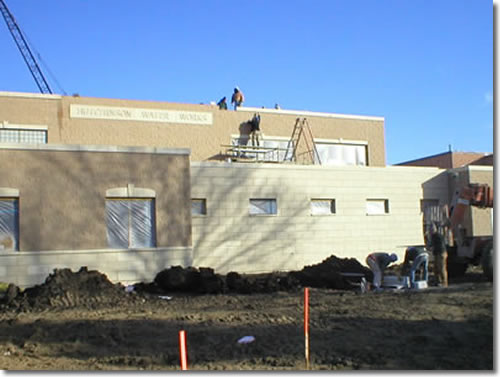
The new Hutchinson plant, under construction in December 2006.
Biological processes have long been a staple in the treatment of wastewater, which is often aerated to stimulate bacteria and other organisms that consume most of the waste materials.
The same technology is available for drinking water, but one of the biggest impediments to its implementation has been the public’s perception of the process. “Put bugs in our drinking water?” is a typical reaction, according to Eric Meester, an engineer with Earth Tech, Inc. of Plymouth, Minnesota.
Meester added that the longtime success of chemicals for drinking-water treatment is another reason for resistance to alternative technologies. “The success of chemical treatment has been documented for a long time. Biological removal has occurred naturally for longer, but no one looked for it or [questioned] why it existed.”
It was this discovery in Hutchinson, a central Minnesota city with approximately 14,000 residents, that helped lead to the decision to incorporate biological treatment for its new water treatment plant, scheduled to go on-line in March of 2007.
Hutchinson’s water system has consisted of five wells feeding an iron-removal plant that is divided into two treatment trains called the East Plant and West Plant. Part of the original facility when it was constructed in 1960, the East Plant has been used only during period of high demand since a 1983 addition, known as the West Plant.
The city was puzzled by the higher chlorine demand that occurred when they used the East Plant. Working with Earth Tech, the city discovered that its groundwater had naturally occurring ammonia, which was creating the higher chlorine demand. Further investigation revealed why the ammonia was an issue only in the East Plant.
The East Plant has a conventional filter, which is backwashed with treated (chlorinated) water, which reduces the possibility of biological activity. The West plant has a Greenleaf filter, a rapid-gravity filter based on siphon-control, rather than valve-control, technology. “The way it’s constructed,” explained Hutchinson water system supervisor Dick Nagy of the Greenleaf filter, “it uses its own backwash water. It’s set up into four cells, so you use the effluent from the other three cells to backwash the fourth, and that’s not chlorinated.”
Nagy added that the West Plant has higher levels of dissolved oxygen (D. O.). “The way the Greenleaf filter works, the water cascades over this weir, falls into this chamber, and goes into the filters. It seems to be creating its own higher levels of D. O. in the water.”
The conditions in the West Plant, it was found, created natural biological nitrification, which was reducing the ammonia.
These discoveries, said Nagy, “set off the whole chain of events. As time went on, we had to find a way to deal with the ammonia, and some other issues started coming up like corrosiveness and meeting the copper limit [the city has been in exceedance of the action level for copper], the aging of the infrastructure, and the plant itself, creeping up on our maximum design [limits], not being able to produce enough water.”
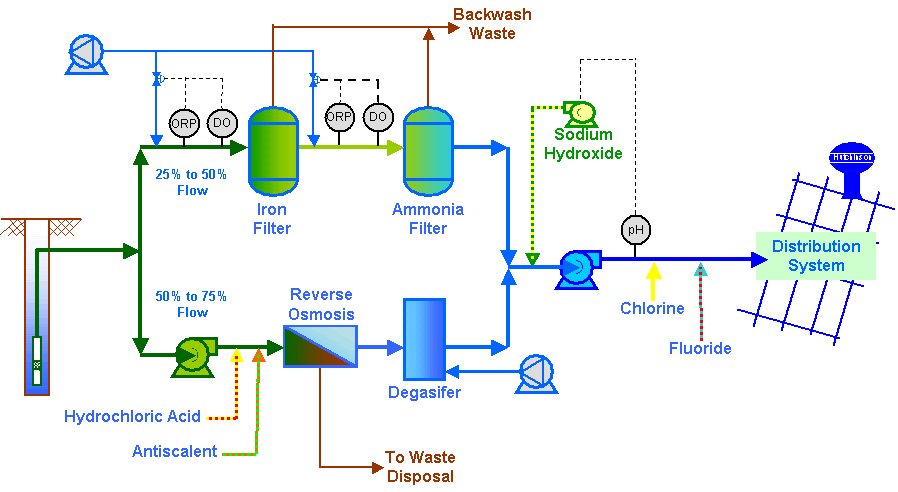
A schematic of the new plant.
In looking at a new plant, the city considered biological filtration as it explored options to reduce both ammonia and iron as well as address the issues with corrosion. “We figured we’ve got biological treatment now, there shouldn’t be a reason we can’t do it intentionally,” said Nagy, adding that they considered a complete biological facility but had to abandon that plan since it wouldn’t deal with the corrosiveness.
“We figured we’ve got biological treatment now,
there shouldn’t be a reason we can’t do it intentionally.”
Reverse osmosis (R. O.) was considered since it would remove the iron and ammonia as well as soften the water, which would allow for adjustment in the pH and reduce corrosion. However, Nagy said the expense of a complete R. O. system didn’t make sense. “R. O. would have killed the bird with one big stone—more than what was needed.”
Finally, the city settled on a holistic approach to produce a blend of water that would be treated with biological filtration for the iron and ammonia and reverse osmosis for the corrosiveness.
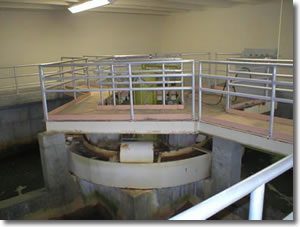 |
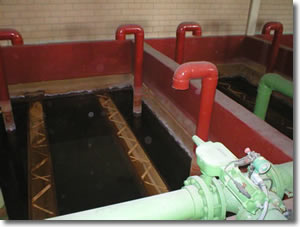 |
|
Left: the East Plant of the existing system. Right: The West Plant, where natural biological nitrification has been taking place.
|
|
The water coming into the plant will be split with approximately 75 percent going through the reverse-osmosis membranes; the remainder of the raw water will go through the biological process, consisting of seven sand filters, the first two for iron and manganese and the others for ammonia. Meester says the objective is “to provide an environment conducive for the biological activity.”
The amount of oxygen provided to create that environment differs between the filter for iron and the filter for ammonia and manganese. In the iron filter, aeration will be controlled to provide just enough oxygen for biologically mediated oxidation to occur but not enough to chemically oxidize the iron.
Meester explained that iron oxidation occurs faster biologically than chemically with the right oxygen conditions. “You provide an environment so the bacteria, not the chemicals, oxidize the iron. It’s based on a rate of reaction.”
The ammonia differs from iron in that this process requires higher oxygen concentrations for biological oxidization. Because of this, in the filter for ammonia and manganese, aeration will be controlled to maximize the dissolved oxygen concentration to encourage the nitrifying bacterial growth. Under oxygenated conditions, the nitrifying bacteria oxidize to nitrite and then to nitrate, which will be at a level of 1.5 parts per million, well below the maximum contaminant level for nitrate.
“You put the right conditions across the media,” said Nagy, “and the bacteria will grow and flourish in that media and convert the ammonia to nitrate, and then it’s a simple chlorination process after that.”
The $14 million project includes the new plant—which will nearly double the utility’s capacity, from 3.5 million to 6.5 million gallons per day—along with one new well and a 1.5 million gallon above-ground reservoir.
Construction started in April 2006. The plant is scheduled to go on-line in March 2007.
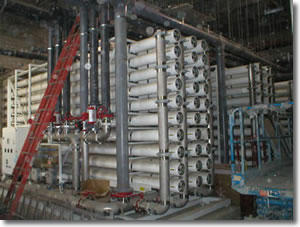 |
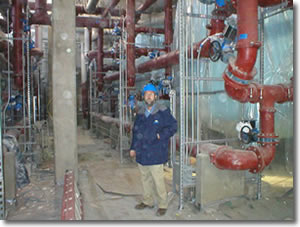 |
|
The reverse-osmosis system, at left, in the new plant has three skids with 30 tubes on each. It is a two-stage system with 20 vessels in the first-stage and 10 in the second. At right is Dick Nagy by the newly installed filters for the biological nitrification.
|
|
Of interest
Community Commitment Results in Innovative Water Plant in St. Martin